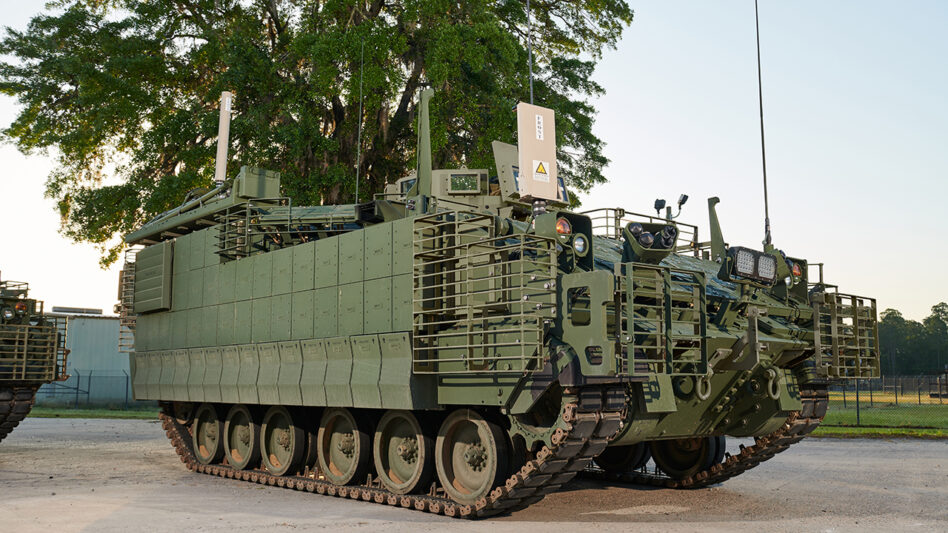The autumn of collabs continues. Yesterday, ground autonomy company Forterra announced that it’s collaborating with defense giant BAE to “rapidly prototype” an autonomous Armored Multi-Purpose Vehicle (AMPV). The partnership is the first to be announced as part of a push to upgrade the AMPV’s capabilities, unveiled last month.
“Working with BAE puts Forterra’s autonomy stack onto frontline programs and demonstrates BAE’s ability to work with non-traditional tech companies,” Forterra’s VP of Defense Growth Pat Acox told Tectonic. “The AMPV is replacing thousands of M113s, so partnering with BAE is not only high impact, but it will be central to military modernization for BAE’s customers.”
The two companies say they plan to field a prototype of the autonomous vehicle by next year. Anyone else starting to see a trend in all of these startup-prime partnerships?
Off-roading: First, a bit about Forterra. The company was founded way, way back in 2002 as Robotic Research Autonomous Industries and rebranded to Forterra in early 2024. It has made a name for itself by building autonomous systems for vehicles—particularly those operating in complex, off-road environments, such as a battlefield.
The company’s flagship product is a vehicle-agnostic autonomy stack called AutoDrive.
- Forterra bills the system as a “full stack solution,” including hardware, software, and sensing.
- AutoDrive can take pretty much any vehicle—no matter how big or complex—and make it autonomous.
- Forterra says AutoDrive has been integrated on more than two dozen vehicles made by companies including Polaris, General Dynamics, Mack, Rheinmetall, and General Dynamics.
“[AutoDrive’s] open architecture and mission-module framework allow the autonomy stack to adapt to the specific requirements of each vehicle platform—whether in power systems, control interfaces, or sensor suites,” Acox said.
The DoD is also a pretty big fan of Forterra and its tech. The company:
- Worked with DEVCOM and Ground Vehicle Systems Center (GVSC) on the Autonomous Transport Vehicle – System (ATV-S).
- Played a part in PM-FP and DIU’s Ground Expeditionary Autonomous Retrofit System (GEARS).
- Was selected to build one of the prototypes for the Army’s Robotic Combat Vehicle (RCV)
- Designed an unmanned, off-road, high-mobility, payload-heavy platform for the Marine Corps’ ROGUE Fires program.
Built different: The AMPV—built by BAE Systems—will be another heavy-duty arrow in Forterra’s autonomous quiver. The tracked vehicle—think Bradley-like, but new and modular—entered full-rate production in 2023 and is slated to replace the Army’s aging fleet of M113 APCs.
(The Army awarded BAE a $797M contract in 2023 for full production of AMPV, and has tacked on over $300M since then, bringing the total program value to over $2.28B. Phew.)
Acox said that an autonomous version of the AMPV could support the Army in everything from recon to frontline combat to large-scale swarmed operations. In particular, he highlighted how helpful it could be for resupply and logistics.
And it doesn’t sound like they’re stopping there. “Successfully integrating and deploying autonomous AMPVs gives Forterra a strong proof point on a flagship U.S. Army vehicle, making it easier to expand autonomy integration to other BAE platforms,” Acox added.
Buddy-buddy: Plus, we’re likely to see more partners soon.
When BAE announced the plan to use internal R&D funds to “produce various technologically-advanced prototypes [of the AMPV] equipped with different capability kits,” built alongside industry partners, they also said they’ll be integrating everything from cUAS, to unmanned turrets, to AI-powered targeting. Wonder who will join the BAE party next.

